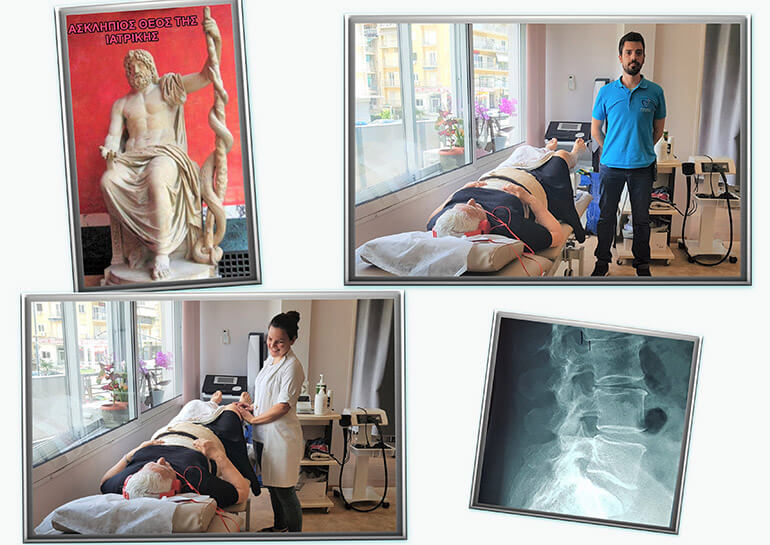ALEXANDROS BLETSAS PHYSIOTHERAPY CENTER
Lumbar Spine Traction
Indications for decompression treatment of the spine.
(Lumbar Traction)

- Lumbar traction application after evaluation.
- Lumbar spine traction is integrated in the treatment plan taking into account its mechanical effects.
- The patient is completely relaxed - stable in his/her position and actively participates in the process of relaxation.
- The magnitude of the traction force should be enough to produce an increase of the intervertebral space and the foramen, an increase of the articular space, a passive dilation of the ligaments and the articular capsules and other structures in the area of the spine.
- The patient should feel no discomfort/phobia and/or insecurity.
- The position of the patient is determined by the specific situation at hand (it is very important to provide adequate comfort and relaxation to the patient).
- When in supine position, the emphasis is placed on relaxing the lower limbs (on a stool) and bending the hips by 45 to 90 degrees to support the shins in order to reduce lumbar lordosis. The motion axis is just below the motion axis of the pelvis.
- Assessment after treatment.
- Problems/dysfunctions of the intervertebral discs, apical joints and other supporting elements of the spine, muscles and ligaments.
- Projection of the gelatinous substance of the nucleus pulposus of the intervertebral disc (without an obvious neurological, radicular semiology).
- Bulging of the intervertebral disc is an indication for lumbar traction application.
- Muscle spasm is an indication for lumbar traction application.
- Apical joints (facets) syndrome.
- Apical joints (facets) osteoarthritis.
- Traction - tension release of the area and disruption of the vicious cycle of irritation that is created.
- Mechanical irritation or folding of soft tissues located in the spinal foramen area, such as the ligamentum flavum (occurs following overextension or overexertion of the area).
- Musculoligamentous injuries or sprains, partial or total rupture of bursae, muscles or ligaments, intense muscle strain with accompanying muscle cramps, ischemia and creation of a pain-contraction vicious cycle.
- Lower back pain syndrome with localized or reflected pain symptoms.
- During the acute stage, no traction other than mild passive dilation with cryotherapy should be applied
Small grade spondylolisthesis (asymptomatic). - Atypical lower back pain syndromes.
- Assessment of the patient's condition on normal, mechanical, ergonomic ground in which the lower back pain syndrome emerges and develops.
- Increase of the intervertebral space thus increasing the space for restoration of the projection.
- Reinforcement of the posterior longitudinal ligament by exerting a centripetal force onto the displaced material.
- Suction effect as a consequence of the previous two impacts.
After completion of the traction application, apply massage techniques and electrical stimulation for analgesia (dejere). - Complete rehabilitation
- Pain alleviation
- Active and fast return to everyday activities.
- The pain emerges from the apical joints and the posterior longitudinal ligament and not from the intervertebral disc region.
- The degeneration of the disc, in addition to the narrowing of the intervertebral space it causes, also affects the facets. This causes erosion of the cartilage leading to osteoarthritis of the apical joints, as well as bursae irritation. All of these conditions can be considered sources of pain.
- The most common cause of pain is intervertebral disc dislocation rather than intervertebral disc damage. This is where the effectiveness of lumbar traction application in relieving pain lies.
- Release of trapped nerve root, membrane, bursae.
- Release of any adhesion to these structures, especially the nerve root.
- Stretching the contracted and painful synovial bursa.
- Temporarily realigning any partial subluxation of the apical joints.
- Temporarily restoring mild projections of the nucleus pulposus material.